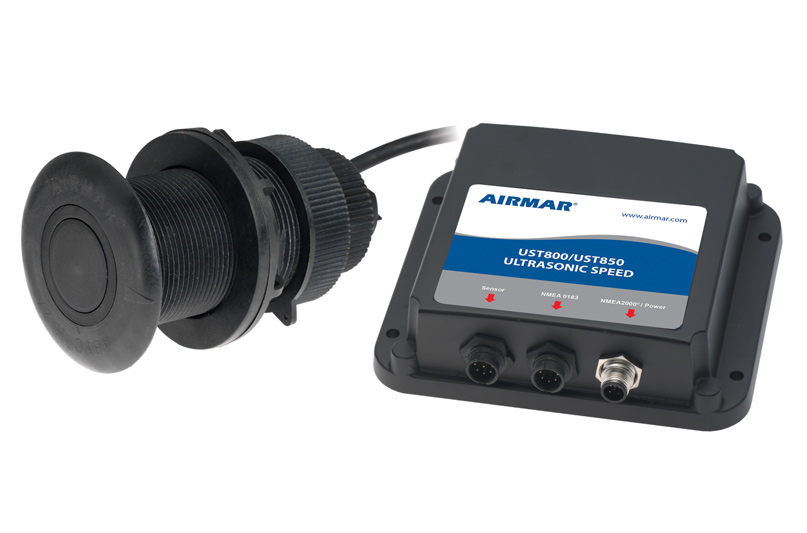A marine transducer sends sound waves through the water and then receives echoes that the fish finder or multifunction display can interpret and display on a screen. They come in a lot of shapes and sizes, so let’s take a look at the most popular options available for your boat.
Transom mount transducers are installed on the boat’s transom, directly in the water and slightly below the hull. They are recommended for planing hulls less than 30 feet in length, such as powerboats with an outboard. They are not recommended for boats that operate at high speeds or larger twin engine inboards because the bubbles from the propellers reduce the performance.
In-hull or shoot-through transducers are glued to the inside of the hull, and the signal is transmitted and received through the hull. As a result, they will only work with solid fiberglass hulls (i.e., no foam core) and not aluminum, steel or wood hulls. They are much easier to install but there is a significant loss of sonar performance and reduced fish detection. The advantage is that they work well at high speeds and you don’t have to drill a hole in your boat.
Through-hull transducers, as a rule, provide the best performance and are mounted through a hole drilled into the hull of the boat. You have two options for through-hull transducer: with fairing blocks or with tilted elements.
A through-hull with fairing blocks must be installed with angled fairing blocks, both inside and outside the hull, to ensure proper vertical alignment and a secure fit. Many boat builders mold in recessed transducer pockets to protect the transducer from damage.
Tilted element transducers are also installed with a hole drilled in the hull of the boat. However, a tilted element transducer has an internal element that acts as an offset to ensure the sonar beam is directed straight down and does not require a fairing block.

On a recent installation, we recommended the Garmin GSD25 Premium Sonar Module, which includes true dual-channel 1-kW CHIRP plus SideVü and ClearVü scanning sonar for amazing images below the water. We paired this with an Airmar SS164 transducer with a 20-degree tilt. This low-profile, through-hull transducer is designed for fast boats because the ceramic arrays are tilted inside the housing, giving the perfect vertical beam with maximum energy to see what is below.
Two popular transducers right now are also from Airmar. The P75M is a good solution for solid fiberglass hulled boats. It is a 600-watt, single frequency CHIRP in-hull transducer working on the medium frequency band (80-130kHz). This frequency is good for inshore, with target definition out to 700 feet, and is the perfect solution for trailered or lifted boats. The P95 is a 300-watt, single-frequency CHIRP in-hull transducer working on the medium frequency band (95-155kHz) for target definition out to 500 feet. This transducer is designed for smaller boats up to 26 feet with solid fiberglass hulls.
Also note that to take full advantage of your CHIRP fish finder, you will need a CHIRP transducer. Companies like Raymarine offer transducers engineered with ceramics to operate over a broad range of frequencies along with the ability to not only look down but to the side or all around. Many multifunction displays or fish finders require multiple transducers. As a result, manufacturers like Simrad have incorporated broadband, CHIRP, structure scan, and down scan in one transducer. This is a great way to save money.
When you are installing a transducer, location is critical, and different for sailboats and powerboats. The goal of selecting a transducer location is to minimize nearby obstructions and through-hulls that will create turbulence and bubbles, and to ensure the transducer will always be in the water. For example, one typical location on sailboats is in front of the keel, while for powerboats you want it aft and center, so it stays in the water when you’re planing. A poor location will result in very poor performance, so do some research, read the instructions thoroughly, and make sure it’s right for your boat.
Next, it’s a good idea to test your transducer before you permanently install it to make sure there aren’t any issues. Once the bedding compound is set, it’s going to take a lot of work to repair or move it to a better location. Installation will most likely require a haul-out unless you select an in-hull transducer model. And of course follow the manufacturer’s instructions to maintain your warranty and get the best out of your transducer.